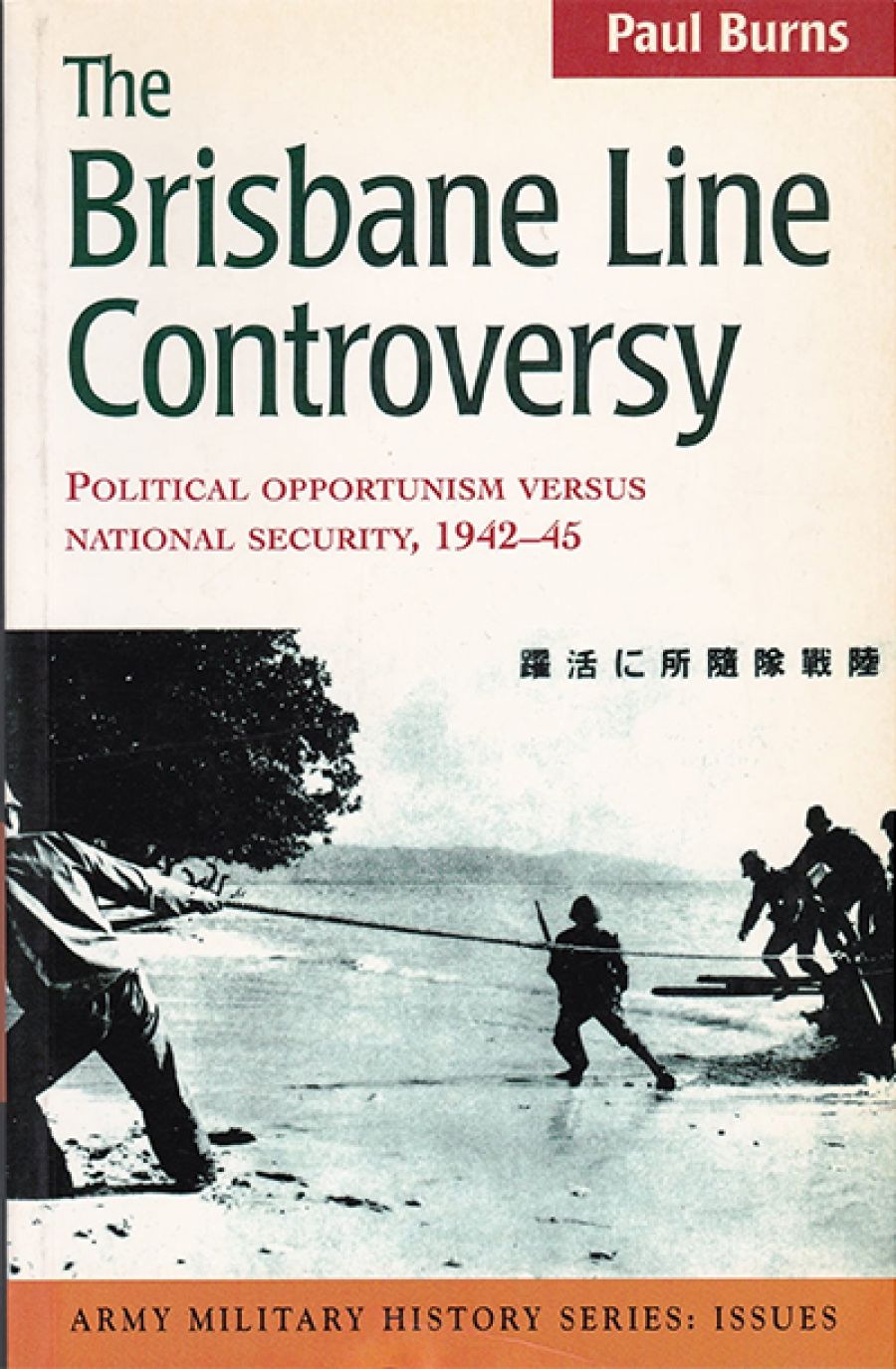
- Free Article: No
- Contents Category: Military History
- Review Article: Yes
- Online Only: No
- Custom Highlight Text:
The title is not provocative: The Brisbane Line Controversy, but Paul Burns’s subtitle flags the partisanship that will mark his study. This is a case, he contends, of ‘Political Partisanship versus National Security 1942–45’. His conclusion is unobjectionable: ‘belief in a “Brisbane Line” was our barometer of fear about the vulnerability of our own continent which no Australian Army could negate’. In political demonology, the Brisbane Line signifies the intention of the Menzies–Fadden conservative governments of 1939–41 to abandon all but the south-east corner of Australia to the Japanese, should an invasion come. Burns is keen to absolve Menzies and his colleagues of blame and to find where, and with whom, the notion of the Line originated. In the process he indicts Labor front-bencher Eddie Ward, whose allegations about a Brisbane Line led to a Royal Commission in the election year of 1943.
- Book 1 Title: The Brisbane Line Controversy
- Book 1 Biblio: Allen & Unwin, $29.95 pb, 254 pp
The anxieties that the controversy ventilated had a long history. Fear of invasion flared periodically in Australia throughout the nineteenth century, expressed in novels, editorials, cartoons, parliamentary questions, and focussed on predatory Asiatics – Chinese, Japanese, even Cambodians.
Such fears were particularly strong at the beginning of this century after the Japanese naval victory over Russia in 1905. The Director of Naval Forces, Captain W.R. Creswell, spoke in 1907 of the danger of ‘German, Jap and Chinese colonies’ being ‘carved out of the north and west of Australia’. Brought out to inquire into the state of Australia’s defence, Lord Kitchener felt nowhere north of the Maroochy River could be held against invasion. So the Brisbane Line begins with the Kitchener Line.
Burns’s book illuminates many aspects of Australia’s defence strategy, considering how such questions as these were answered: Should the country expect raids or invasion? Should attack be resisted off Australia’s shores? (It was: in Malaya and Singapore with disastrous consequences; in New Guinea, in what eventually became a victory). In defining what northern Australia was, a 1936 sub-committee of the Defence Committee effectively, if inadvertently, gave currency to a Brisbane Line. The vital south-eastern region, the industrial hub of Australia, would be defended. This was also the view of General Iven Mackay who, in a memorandum, wrote of the need to allocate troops ‘without undue dispersion and risk of defeat in detail’. This would have to be done, he judged, in an area ‘inclusive of BRISBANE and MELBOURNE’. A few days after his arrival in Australia in March 1942, General Douglas MacArthur spoke publicly of ‘a Brisbane line’. Thus rhetorically, and in popular understanding, it did exist. This was no consolation to the people of Townsville or of Tasmania. Evidently Launceston was to be completely destroyed if it could not be defended. Fortunately, the Japanese did not come at Australia the long way around.
Burns’s arguments are to an extent self-defeating. His evidence clearly shows how the notion of a Brisbane Line developed, and yet he wants to deny that it really existed. What distracts him is a felt need to attack Labor – Ward, Prime Minister John Curtin and Frank Forde in particular – for their ascription of a Brisbane Line to a defeatist conservative government. Ward is accused of a ‘febrile and imaginative misinterpretation’ and – worse – of ‘endangering national security’. Major H.V. Howe, allegedly one of Ward’s sources, was ‘a strident Labor supporter’. Curtin ‘lacked expertise in defence matters’: but so did Menzies.
The stridency is Burns’, and it dissipates the impact of the important research that he has undertaken. He speaks of Ward’s hatred ‘of those who epitomised the UAP – Menzies and his ilk’. Such feelings, he reckons, were ‘representative of Labor’s left-wing radicals (and the Communist Party of Australia)’. This is a pointless slur by association. Curtin is snidely and resentfully treated too, as one taking on ‘the trappings of a national hero’. It may indeed be that ‘Labor’s crushing victory in the 1943 election’ was ‘almost certainly in part due to the Brisbane Line controversy’. Insofar as that was the case, the political lessons were not lost on Menzies when he seized the opportunity provided by the Petrov Affair in 1954, another election year. At one point, Burns contends anachronistically that the Brisbane Line was a ‘New Left myth’ and blames Humphrey McQueen. But as his own research shows, the Line had substance: it expressed both the proper apprehensions of the military about how much of Australia could be defended and the less rational anxieties of all Australians, north, south and west of ‘the Line’, as to whether their tenuous lodgment on this continent could much longer endure. The Curtin government’s exploitation of such fear was good and shameless politics. Burns’ indictment on that score is just, though one that hardly needed to be so laboured. The Brisbane Line Controversy tells us much of what its tide promises, even if its author appears just as interested in reviving the partisan antagonisms of the 1940s.


Comments powered by CComment